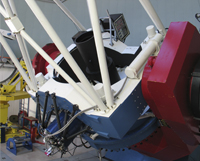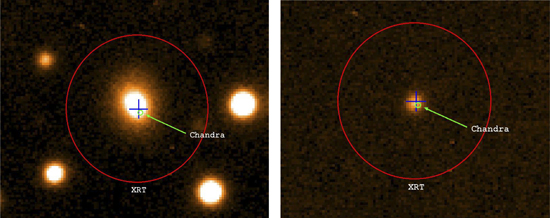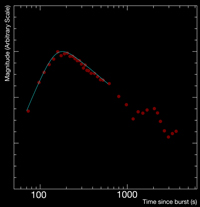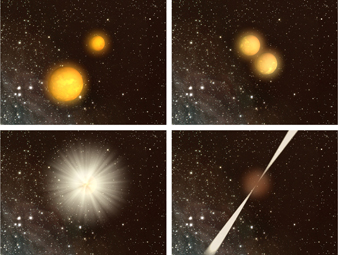Fusion in the Universe: gamma-ray bursts Understand article
Henri Boffin from ESOw1 in Garching, Germany, follows the mystery of gamma-ray bursts from their first discovery to the most recent research on these dramatic astronomical explosions.

La Silla Observatory is dedicated
to the study of gamma-ray bursts
Image courtesy of ESO
It all started just like a James Bond movie. During the 1960s, in the midst of the Cold War, the United States launched a series of satellites sensitive to gamma radiation to monitor the Soviet Union’s compliance with the Nuclear Test Ban Treaty, which banned nuclear tests in the atmosphere, underwater and in space. No explosions were detected in the Earth’s atmosphere.
Instead, mysterious bursts of gamma rays were seen that appeared to come from space, as if – as it was later written in the sensational press – aliens were conducting a massive intergalactic war!
Because the few scientists who had access to the (military) data wanted to check all the details, it wasn’t until 1973, six years after their first detection, that the discovery of these enigmatic explosions was announced to the scientific community. Unfortunately, the early gamma-ray detectors couldn’t locate the source of gamma rays in the sky very accurately, leading to a long-standing controversy surrounding their origin.
Flashlight or lighthouse?
Scientists not only did not know where they were, but also could not even tell how far away these explosions were. Did they happen in our neighbourhood – in the Solar System or in our galaxy – or were they much further away? Without knowing the distance, it was not possible to determine the power of these events: were they just ‘sparks’ on the surface of comets, comets falling onto compact stars, or gigantic explosions that challenged our knowledge? The situation was not unlike one in which a person walking at night sees a light in the distance: is it a flashlight (torch) from somebody across the street, the lights of a car far away or the reassuring signal from a distant lighthouse?
Astronomers let their imaginations go wild. At one time, there were about a hundred theories to explain the new phenomenon – more than the number of observed events! As is often the case, advances were made when new technologies emerged, in particular with the launch of scientific satellites dedicated to gamma-ray research.
The BATSE instrument on board the NASA Compton Gamma Ray Observatory revealed that, on a typical day, two or three gamma-ray bursts occur somewhere in the Universe. BATSE also showed that gamma-ray bursts appear from all directions. This seemed to contradict the idea that they originate only in our Milky Way galaxy, because in that case they would show the typical flattened distribution of faint stars. This is because our galaxy is a strongly flattened disc of stars, as shown by the appearance of the Milky Way itself – a band of stars crossing the whole night sky.
Although crucial, these observations did not settle the debate fully and at the end of the 1980s, astronomers were still divided into two fiercely opposed camps: the first believed that gamma-ray bursts were due to ‘local events’ – such as comets falling onto neutron stars – and were located in a halo surrounding our galaxy. The other group dismissed this hypothesis and contended that gamma-ray bursts are dramatic ones, linked to the death of stars and the birth of black holes, and that they occur everywhere in the Universe.
The dispute raged until the Italian-Dutch BeppoSAX satellitew2, launched in 1996, used a combination of X-ray cameras and gamma-ray detectors to show that gamma-ray bursts originate in very distant galaxies. Since then, the most distant gamma-ray burst was found to be located more than 12.8 billion light-years away, which means that we observe it in the state in which it was when the Universe was less than 900 million years oldw3.
The most powerful events since the Big Bang
For gamma-ray bursts to be detectable from Earth, they must release tremendous amounts of energy. The energy released during a gamma-ray burst within a few seconds is thought to be more than the Sun will release during its entire lifetime (about 10000 million years). In other words, these events are so bright that, for a brief moment, they almost rival the whole Universe in luminosity! However, they last for only a very short time, from less than a second to a few minutes.
Apart from the Big Bang itself, gamma-ray bursts are by far the most powerful events known in the Universe. Astronomers have also been able to determine that the explosions disturb a very large region around them – in one case, about 5 500 light-years, which is more than one-fifth of the distance between the Sun and the centre of our galaxy. All the material in this region of space will be ionised; that is, the atoms will be stripped of most, if not all, of their electrons. If there is any life in this region of the Universe, it will most probably be eradicated. In fact, some scientists claim that the Ordovician-Silurian mass extinction, which took place approximately 450 million years ago and in which about 70% of all species on Earth were wiped out, was caused by a nearby gamma-ray burst.
Gamma-ray bursts are thus incredible events that wreak havoc in their galaxies and liberate extremely large amounts of energy. The question of course is which kind of ‘engine’ can trigger such events. The formation of a black hole is a very powerful event, so astronomers began to investigate whether the two – gamma-ray bursts and black holes – could be linked.
Although the details are still far from clear, scientists now believe that the best model to explain gamma-ray bursts is the ‘fireball’. According to this model, during the creation of a black hole, the energy released by the explosion is stored in the kinetic energy of a shell of particles – a fireball – expanding at close to the speed of light. Initially, the density of the exploding material is so high that not even particles as evanescent as photons and neutrinos can escape. As the fireball expands to a diameter of 10-100 billion kilometres, the photon density drops enough for gamma rays to escape unhindered: some of the kinetic energy of the fireball is converted into electromagnetic radiation, resulting in a gamma-ray burst.
Long and short
The wealth of observations on gamma-ray bursts has revealed that they come mainly in two types: long (lasting more than two seconds) and short (lasting from a few milliseconds to two seconds). The difference between the two is not only in their duration: short bursts also consist of higher-energy photons than do long bursts. Clearly, although both types of gamma-ray bursts are associated with black holes, the precise physical origins of the two types must be different.
In recent years, a large international effort has convincingly shown that long gamma-ray bursts are linked with the ultimate explosion of very massive stars (hypernovae), with an initial mass more than 30-40 times the mass of the Sun, as they collapse into a black hole. Key evidence was provided with the help of ESO telescopes in 2003w4. Using the ESO Very Large Telescopew5, astronomers obtained, over one month, spectra of the fading afterglow of a gamma-ray burst. This allowed them to observe the gradual emergence of a supernova-type spectrum, revealing the extremely violent explosion of a star.

Image courtesy of ESO
Several other events have allowed astronomers to connect long gamma-ray bursts with hypernovae. One such event occurred on 11 December 2001 and was observed by the ESA XMM-Newton satellitew6, only eleven hours after the burst was detected. At that time, the object was emitting seven million times more X-rays than a normal galaxy! This allowed XMM to take detailed spectra of the burst, permitting astronomers to detect the tell-tale signature of several elements, such as magnesium, silicon and nickel, which are typically ejected by an exploding star (for more details of the formation of heavy metals, see Rebusco, Boffin & Pierce-Price, 2007). Astronomers were detecting matter recently ejected by a supernova.
Merging stars
What about the short gamma-ray bursts? Until recently, astronomers were unable to detect an afterglow. It was therefore not possible to precisely locate them and thus to deduce the environment in which they formed, or to characterise them by their light curve (variation of brightness over time) or spectrum.

on 7 June 2006, GRB 060607A. The
red dots are the data obtained at the
ESO La Silla Observatory, observing
the afterglow (in near-infrared light)
of the burst. The blue line, fitted to
the data, allows astronomers to
determine the peak of the light curve
and so derive the velocity of the
material. It was found that the matter
moves at a speed very close to the
speed of light.
Click on image to enlarge.
Image courtesy of ESO
Things changed on 9 May 2005 when the NASA/ASI/PPARC Swift satellite detected a gamma-ray burst lasting 40 milliseconds and located it with enough precision to allow astronomers to point ESO’s Very Large Telescope towards it and take images. The burst, named GRB 050509B, was found to sit in a luminous, non-star-forming elliptical galaxy lying 2700 million light-years away.
This makes it difficult for the hypernova model to be invoked because a core-collapse supernova is unlikely in this kind of galaxy, which no longer produces stars and is thus generally devoid of the short-lived massive stars that collapse in hypernovae. On the other hand, luminous, non-star-forming elliptical galaxies host many tight binary systems (two stars orbiting each other closely) composed of compact stars. This supports the other prevailing model, in which gamma-ray bursts are caused when two neutron stars in a binary system merge to form a black hole. To be sure that the hypernova model could be ruled out, astronomers observed the burst for another three weeks, until they were confident that even the faintest supernovae would have been detected. But none were found.
A few months later, astronomers detected, for the first time, the optical afterglow of a short gamma-ray burst. Images obtained at ESO’s La Silla observatory in Chile showed a fading source at the edge of a galaxy.
Astronomers observed the burst, named GRB 050709, for 20 days but did not detect any supernova-like signal. This gives further support to the hypothesis that short gamma-ray bursts occur not as a result of a hypernova but when two very compact stars merge to form a black hole.
In the merging model (see image), two massive stars orbiting each other burn their fuel in about 100 million years and collapse into highly dense neutron stars about 10-20 kilometres in size. Over another 100 million to a few billion years the two objects continue to lose energy, and as they do, their orbit shrinks. Eventually they collide and produce a short gamma-ray burst. The theory also works if one star becomes a black hole, instead of a neutron star, that eventually devours its neutron star partner.

Image courtesy of ESO
Forty years after gamma-ray bursts were discovered, we now know that they appear everywhere in the Universe, from its farthest edge to neighbouring galaxies. We also have an explanation for the two most common kinds of burst discovered. But nature is often more complicated than we tend to believe: with advances in observation techniques, astronomers continue to discover new types of gamma-ray bursts, and the story is thus far from finished.
References
- Rebusco P, Boffin H, Pierce-Price D (2007) Fusion in the Universe: where your jewellery comes from. Science in School 5: 52-56.
Web References
- w1 – ESO, the European Organisation for Astronomical Research in the Southern Hemisphere: www.eso.org
- w2 – BeppoSAX: www.asdc.asi.it/bepposax/
- w3 – Star Death Beacon at the Edge of the Universe (ESO press release): www.eso.org/public/outreach/press-rel/pr-2005/pr-22-05.html
- w4 – Cosmological Gamma-Ray Bursts and Hypernovae Conclusively Linked (ESO press release): www.eso.org/public/outreach/press-rel/pr-2003/pr-16-03.html
- w5 – To learn more about ESO’s Very Large Telescope, see www.eso.org/public/astronomy/teles-instr/paranal.html
- or Pierce-Price D (2006) Running one of the world’s largest telescopes. Science in School 1: 56-60.
Resources
- To learn more about supernovae, see:
- Székely P, Benedekfi Ö (2007) Fusion dans l’Univers: lorsque meurt une étoile géante… Science in School 6: 64-68. www.scienceinschool.org/2007/issue6/fusion/french
- GCN, the Gamma-ray bursts Coordinates Network: http://gcn.gsfc.nasa.gov/
Institutions
Review
This is a very exciting article that introduces and discusses a phenomenon involving a tremendous amount of energy: gamma-ray bursts. The article could be used to stimulate a discussion about the origin and mysteries of the Universe, as well as scientific discoveries and technological advances in research. It could also encourage young students to become interested and involved in astronomy.
Alessandro Iscra, Italy





